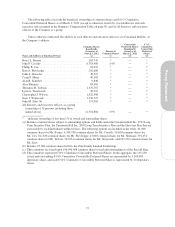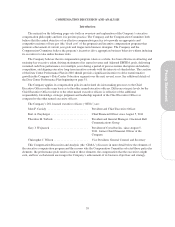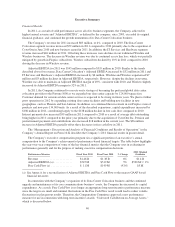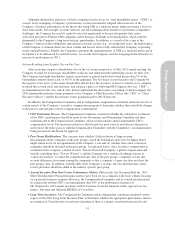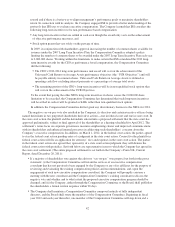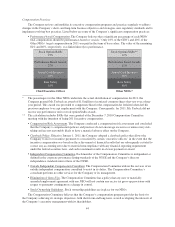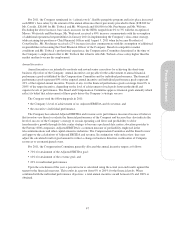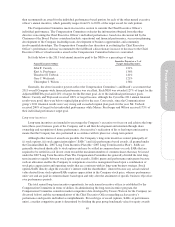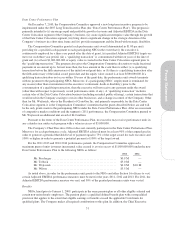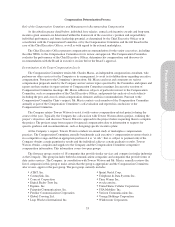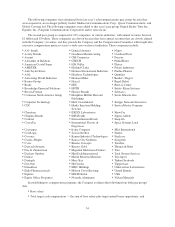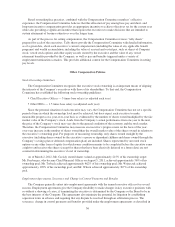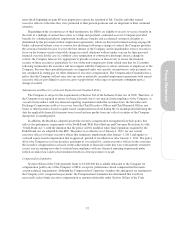Cincinnati Bell 2011 Annual Report Download - page 61
Download and view the complete annual report
Please find page 61 of the 2011 Cincinnati Bell annual report below. You can navigate through the pages in the report by either clicking on the pages listed below, or by using the keyword search tool below to find specific information within the annual report.
For 2011, the Company terminated its “cafeteria-style” flexible perquisite program and in its place increased
each NEO’s base salary by the amount of the annual allowance that it previously provided to them ($38,000 for
Mr. Cassidy, $26,000 for Mr. Torbeck and Mr. Wojtaszek and $16,000 for Mr. Freyberger and Mr. Wilson).
Excluding the above increase, base salary increases for the NEOs ranged from 0% to 3% with the exception of
Messrs. Wojtaszek and Freyberger. Mr. Wojtaszek received a 40% increase commensurate with his assumption
of additional operational responsibilities in January 2011 in implementing the Company’s data center strategy,
while retaining his position as Chief Financial Officer until August 5, 2011 when he became President of
CyrusOne Inc. Mr. Freyberger received a 27% increase in salary commensurate with his assumption of additional
responsibilities in becoming the Chief Financial Officer of the Company. Based on competitive market
conditions and Mr. Torbeck’s professional experience, the Compensation Committee determined at the time of
the Company’s employment offer to Mr. Torbeck that it had to offer Mr. Torbeck a base salary higher than the
market median to secure his employment.
Annual Incentives
Annual incentives are intended to motivate and reward senior executives for achieving the short-term
business objectives of the Company. Annual incentives are payable for the achievement of annual financial
performance goals established by the Compensation Committee and for individual performance. The financial
performance goals represent 80% of the targeted annual incentive and individual performance goals represent
20% of the targeted annual incentive. Payouts, if any, for the financial performance goals can range from 0% to
200% of the target incentive, depending on the level of achievement of such goals between threshold and
superior levels of performance. The Board and Compensation Committee approve financial goals annually which
reflect its belief that achievement of these goals drives the Company’s strategic success.
The Company used the following goals in 2011:
•the Company’s level of achievement of (a) Adjusted EBITDA and (b) revenue, and
•the executive’s individual performance.
The Company has selected Adjusted EBITDA and revenue as its performance measures because it believes
that investors use them to evaluate the financial performance of the Company and because they also indicate the
level of success of the Company’s strategy to sustain operating cash flows and profitability to drive
transformative growth through its data center strategy to become a preferred data center colocation provider to
the Fortune 1000 companies. Adjusted EBITDA is a common measure of profitability employed in the
telecommunications and other capital-intensive industries. The Compensation Committee and the Board review
and approve the calculations of Adjusted EBITDA and revenue. In conjunction with such review, they may
adjust the calculated result or goal amount to reflect a change in business direction, reallocation of Company
resources or an unanticipated event.
For 2011, the Compensation Committee generally allocated the annual incentive targets as follows:
•70% for attainment of the Adjusted EBITDA goal;
•10% for attainment of the revenue goal; and
•20% for individual performance
Upon the conclusion of the year, a payout factor is calculated using the actual year-end results against the
target for the financial measures. This results in a payout from 0% to 200% for the financial goals. When
combined with the individual performance objectives, a total annual incentive award between 0% and 200% is
obtained.
47
Proxy Statement


